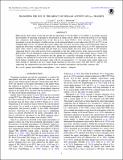Files in this item
Transiting the Sun. II. The impact of stellar activity on Lyα transits
Item metadata
| dc.contributor.author | Llama, J. | |
| dc.contributor.author | Shkolnik, E. L. | |
| dc.date.accessioned | 2016-02-08T12:12:29Z | |
| dc.date.available | 2016-02-08T12:12:29Z | |
| dc.date.issued | 2016-01-22 | |
| dc.identifier | 240749961 | |
| dc.identifier | 92c7f84f-aef0-4963-b721-faa70dae88de | |
| dc.identifier | 84955506472 | |
| dc.identifier | 000368872400081 | |
| dc.identifier.citation | Llama , J & Shkolnik , E L 2016 , ' Transiting the Sun. II. The impact of stellar activity on Lyα transits ' , Astrophysical Journal , vol. 817 , no. 1 , pp. 1-7 . https://doi.org/10.3847/0004-637X/817/1/81 | en |
| dc.identifier.issn | 0004-637X | |
| dc.identifier.other | BibCode: 2016ApJ...817...81L | |
| dc.identifier.uri | https://hdl.handle.net/10023/8175 | |
| dc.description | This work is supported by NASA Origins of the Solar System grant No. NNX13AH79G. | en |
| dc.description.abstract | High-energy observations of the Sun provide an opportunity to test the limits of our ability to accurately measure the properties of transiting exoplanets in the presence of stellar activity. Here we insert the transit of a hot Jupiter into continuous disk integrated data of the Sunin Lyα from NASA’s Solar Dynamics Observatory/EVE instrument to assess the impact of stellar activity on the measured planet-to-starradius ratio (Rp/R⋆). In 75% of our simulated light curves, we measure the correct radius ratio; however, incorrect values can be measured if there is significant short-term variability in the light curve. The maximum measured value of Rp/R⋆ is 50% larger than the input value,which is much smaller than the large Lyα transit depths that have been reported in the literature, suggesting that for stars with activity levels comparable to the Sun, stellar activity alone cannot account for these deep transits. We ran simulations without a transit and found that stellar activity cannot mimic the Lyα transit of 55 Cancari b, strengthening the conclusion that this planet has a partially transiting exopshere. We were able to compare our simulations to more active stars by artificially increasing the variability in the Solar Lyα lightcurve. In the higher variability data, the largest value of Rp/R⋆ we measured is <3× the input value, which again is not large enough to reproduce the Lyα transit depth reported for the more active stars HD 189733 and GJ 436, supporting the interpretation that these planets have extended atmospheres and possible cometary tails. | |
| dc.format.extent | 7 | |
| dc.format.extent | 487461 | |
| dc.language.iso | eng | |
| dc.relation.ispartof | Astrophysical Journal | en |
| dc.subject | Planets and satellites: atmospheres | en |
| dc.subject | Stars: activity | en |
| dc.subject | Starspots | en |
| dc.subject | QC Physics | en |
| dc.subject | QB Astronomy | en |
| dc.subject | 3rd-DAS | en |
| dc.subject.lcc | QC | en |
| dc.subject.lcc | QB | en |
| dc.title | Transiting the Sun. II. The impact of stellar activity on Lyα transits | en |
| dc.type | Journal article | en |
| dc.contributor.institution | University of St Andrews. School of Physics and Astronomy | en |
| dc.identifier.doi | 10.3847/0004-637X/817/1/81 | |
| dc.description.status | Peer reviewed | en |
| dc.identifier.url | http://adsabs.harvard.edu/abs/2016ApJ...817...81L | en |
This item appears in the following Collection(s)
Items in the St Andrews Research Repository are protected by copyright, with all rights reserved, unless otherwise indicated.

